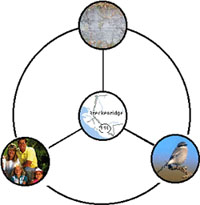
Table of Contents
Methodology
1. Literature Review
A literature review was conducted in order to gain background information
on the property, target species, habitats and areas of concern in conservation
and management of protected areas. Management plan frameworks for protected
areas were researched in order to find a biodiversity management framework
that suited the context of the property. The chosen format (adaptive planning
with a focus on species/habitat management) was altered to adhere to the
requirements set by the NCC.
The data sources for the literature review included government documents,
documents from the NCC pertaining specifically to the property, general
documents from the NCC (including the Stewardship Manual), documents from
international conservation groups, articles from scientific journals,
books, and topographic and road maps.
2. Personal Communications
Informal communications between ourselves, the NCC, and the landowners
were carried out in person, over the telephone and by e-mail. These communications
allowed additional site-specific information to be obtained and evaluated
with regards to the background information uncovered in the literature
review.
3. Site Visits
Site visits were conducted in order to view the access areas and other
areas of concern, the main habitats, assess the main human threats, disturbances
and the work that would be needed in phase one of the management plan.
Also, adjacent land uses were observed and The main access points were
examined, photographed and defined and buildings on the property were
also viewed during these visits. Location and size, where appropriate,
of habitats, access points, and buildings were determined and diagrammed
based upon maps and conversations with the landowners.
4. Vegetation Sampling/Habitat
Description
To determine whether the property meets the requirements of the Sedge
Wren, Grasshopper Sparrow, Short-Eared Owl and Eastern Loggerhead Shrike,
a superficial survey of the pasture was conducted to determine size, vegetation
composition, and vegetation structure. This was done using maps and information
provided by the landowners, as well as a walkthrough of the pasture. A
visual survey allowed for estimations of hawthorn tree density, approximate
vegetation height, and general pasture composition. General pasture composition
was determined through scientific knowledge of the students in regards
to plant forms and species.
The tree species within the forest habitats and approximate age of the
majority within each stand were described through personal communications
with the landowners.
5. Determining the
Status of a Species
The status of the flora species were determined using Les espèces
menacées ou vulnérables du Québec because this source
was endorsed by the NCC, through its use by Geoffrey Hull during his 1999
flora species inventory. For the fauna species, statuses were determined
from reports by the Committee on the Status of Endangered Wildlife in
Canada (COSEWIC), the Canadian Wildlife Service (CWS) Québec Region,
and sitings on the property by the Province of Quebec Society for the
Protection of Birds (PQSPB) and the landowners.
Each target fauna species was objectively ranked according to its status
and the species’ requirements that need to be considered as priority
were determined. The suitability of the property for the target fauna
species was assessed by examining the amount of suitable habitat, the
ecology and requirements of each species and the seriousness of the threats
to each species present on the property. The ecology of each species included
information about their reproduction, nesting information, known sensitivity
to edge effects, and preferred habitat.
Target flora species were prioritized according to the seriousness of
the threats to each present on the property.
